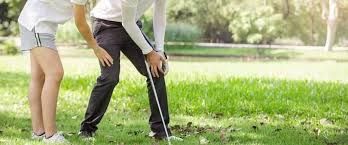
Don’t let a meniscus tear take you off course
Don’t let a meniscus tear take you off course
Gorgeous summer weather seems like the perfect time to head out to the links and hit a few golf balls. Time on the golf course is a great opportunity to enjoy some fresh air, spend time outdoors, and get some exercise that might actually be fun.
But whether it’s due to age, insufficient warm up, or just plain bad luck, golfing may also be the perfect time to injure a knee… particularly your meniscus.
How do you know if your meniscus is torn?
If you notice a new pain in your knee, especially when you’re twisting or rotating, you’ll probably want to visit a doctor to be sure it’s not serious. If it is serious, it’s best to begin appropriate treatment as soon as possible to avoid additional damage. Be particularly mindful of these symptoms:
● Popping in the knee during movement
● Locked feeling of the knee
● Difficulty extending the knee
● Swelling and/or stiffness in the knee
● Limited motion of the knee
● Fluid accumulation in the knee joint
What does your meniscus do?
You actually have four menisci (that’s plural) – two in each knee – that act as shock absorbers between your tibia and femur. When you walk or run, you put two to eight times your body weight on that joint. The meniscus absorbs this weight and distributes it evenly throughout the joint.
Why makes a meniscus more likely to tear?
There are a number of reasons you may tear your meniscus, but age is definitely a factor. The knee rotation required for a golf swing does put pressure on your knee. But as you age, your meniscus also loses some of its natural blood supply and becomes less elastic. That means the same amount of rotation your body handled easily in your twenties may now lead to a tear.
How can a torn meniscus be fixed?
Most meniscus tears will require surgery for a full recovery, but the type of surgery depends on the type and severity of the tear:
Arthroscopy requires small incisions in the knee to insert the camera into the injured joint. This type of surgery is minimally invasive and typically has a relatively short recovery time.
Partial Meniscectomy may be required if the damaged meniscus can’t be repaired.
Meniscus Injury Repair can be done when it’s possible to sew the edges of the torn meniscus back together. This option allows more normal function of the knee and protects the articular cartilage more than if part of the meniscus is removed entirely. Meniscal repair is more commonly used for younger patients whose menisci haven’t degenerated.
How can you rebuild your strength after a meniscus injury?
After any meniscus surgery, you should expect to work hard to rebuild your strength and be patient as you let the injury heal. It is not uncommon for patients to take more than eight weeks to walk again after a meniscal injury.
If you think you’ve injured your meniscus – or even torn one – it’s important to seek immediate medical attention. Early treatment will help avoid additional damage and possibly even streamline your treatment options.
Since 1972, the specialists at DOC Orthopaedics and Sports Medicine have been committed to providing exceptional orthopaedic care through innovative techniques, quality services, patient communication and education. With specialties ranging from general orthopaedics and physical therapy to sports medicine, joint replacement, and more, the doctors at DOC Orthopaedics and Sports Medicine can provide local expert care for any orthopaedic disorder or injury and help put your life back in motion.

